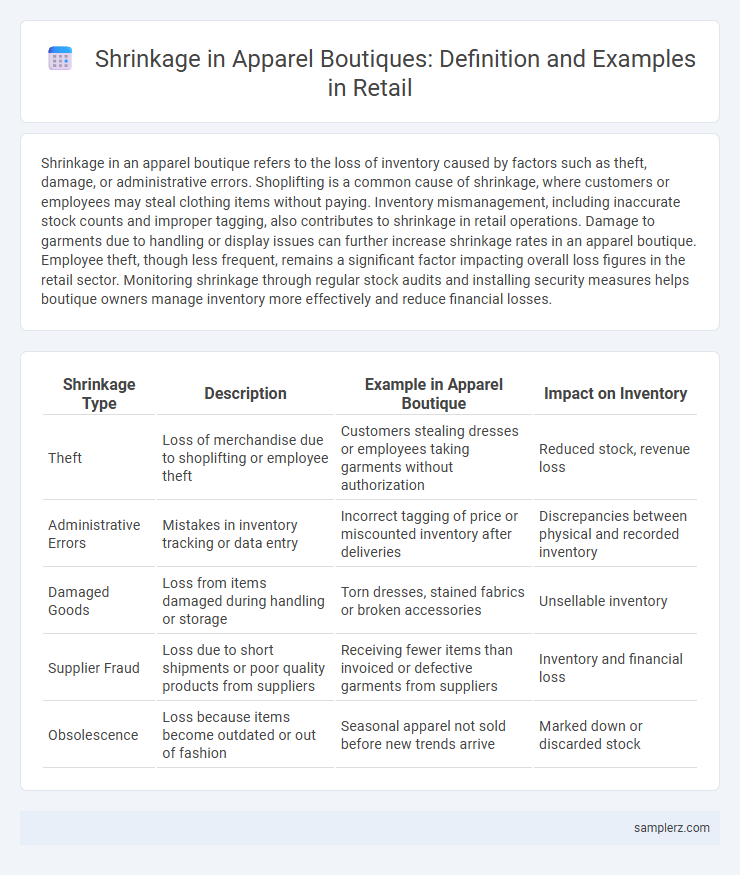Shrinkage in an apparel boutique refers to the loss of inventory caused by factors such as theft, damage, or administrative errors. Shoplifting is a common cause of shrinkage, where customers or employees may steal clothing items without paying. Inventory mismanagement, including inaccurate stock counts and improper tagging, also contributes to shrinkage in retail operations. Damage to garments due to handling or display issues can further increase shrinkage rates in an apparel boutique. Employee theft, though less frequent, remains a significant factor impacting overall loss figures in the retail sector. Monitoring shrinkage through regular stock audits and installing security measures helps boutique owners manage inventory more effectively and reduce financial losses.
Table of Comparison
| Shrinkage Type | Description | Example in Apparel Boutique | Impact on Inventory |
|---|---|---|---|
| Theft | Loss of merchandise due to shoplifting or employee theft | Customers stealing dresses or employees taking garments without authorization | Reduced stock, revenue loss |
| Administrative Errors | Mistakes in inventory tracking or data entry | Incorrect tagging of price or miscounted inventory after deliveries | Discrepancies between physical and recorded inventory |
| Damaged Goods | Loss from items damaged during handling or storage | Torn dresses, stained fabrics or broken accessories | Unsellable inventory |
| Supplier Fraud | Loss due to short shipments or poor quality products from suppliers | Receiving fewer items than invoiced or defective garments from suppliers | Inventory and financial loss |
| Obsolescence | Loss because items become outdated or out of fashion | Seasonal apparel not sold before new trends arrive | Marked down or discarded stock |
Common Causes of Shrinkage in Apparel Boutiques
Common causes of shrinkage in apparel boutiques include shoplifting, employee theft, and inventory mismanagement. Damaged or spoiled goods also contribute, as do pricing errors and vendor fraud. Implementing stringent security measures and inventory controls helps minimize these losses.
Employee Theft: A Major Shrinkage Example
Employee theft significantly impacts apparel boutique shrinkage, often accounting for up to 40% of total losses. Common instances include unauthorized discounts, stealing merchandise during busy hours, and manipulating inventory records. Implementing strict inventory controls and employee monitoring systems can substantially reduce these internal theft occurrences.
Shoplifting Incidents in Clothing Stores
Shoplifting incidents in apparel boutiques often involve the theft of high-demand items such as branded jackets, designer dresses, and seasonal accessories, causing significant inventory shrinkage. Surveillance footage analysis reveals that repeat offenders frequently target fitting rooms and unattended displays, exploiting gaps in staff vigilance. Implementing advanced RFID tagging and employee training programs can substantially reduce these losses by enhancing item tracking and theft prevention.
Inventory Mismanagement Leading to Shrinkage
Inventory mismanagement in an apparel boutique frequently results in shrinkage due to inaccurate stock tracking, leading to overstocking or understocking issues. Failure to implement systematic inventory audits causes discrepancies between recorded and actual stock levels, facilitating unnoticed losses. Poorly organized inventory systems increase the risk of misplaced or damaged items, directly impacting profit margins.
Vendor Fraud and Incorrect Deliveries
Vendor fraud in apparel boutiques often manifests through short shipments, where suppliers intentionally deliver fewer items than ordered, causing inventory discrepancies and financial losses. Incorrect deliveries, such as receiving damaged goods or wrong merchandise, contribute to shrinkage by increasing return rates and complicating stock management. Frequent occurrences of these issues undermine inventory accuracy and reduce overall profitability in retail operations.
Administrative Errors Affecting Stock Levels
Administrative errors such as incorrect stock entries, mislabeling of inventory, and inaccurate transaction records frequently cause shrinkage in apparel boutiques. These mistakes lead to discrepancies between recorded and actual stock levels, resulting in lost sales opportunities and increased reordering costs. Implementing robust inventory management systems and regular audits can mitigate shrinkage caused by administrative inaccuracies.
Lost Merchandise During Transfers
Lost merchandise during transfers significantly contributes to shrinkage in apparel boutiques, where inventory moves between storage, retail floors, or satellite locations. Misplaced or unaccounted items during these internal transfers often result from inadequate documentation or handling errors, leading to financial losses. Implementing real-time tracking systems and standardized transfer protocols can reduce shrinkage by ensuring accurate inventory records throughout the transfer process.
Fitting Room Theft Tactics
Fitting room theft in apparel boutiques involves tactics such as switching price tags on high-value items or removing security tags before leaving. Shoplifters often bring reusable bags to conceal stolen merchandise quickly during fitting room visits. Implementing RFID tags and discreet monitoring helps retailers reduce shrinkage caused by these covert theft methods.
Damage and Spoilage of Apparel Goods
Damage and spoilage in an apparel boutique often result from improper handling, exposure to moisture, or poor storage conditions, leading to unsellable inventory. Torn fabrics, color fading, and mold growth significantly reduce product value and increase shrinkage rates, impacting overall profitability. Implementing quality control measures and climate-controlled storage can minimize damage and spoilage losses in retail apparel environments.
Return Fraud in Boutique Settings
Return fraud in apparel boutiques often involves customers returning stolen merchandise or used items for a full refund, significantly contributing to inventory shrinkage. Boutique settings with limited security measures and personalized service approaches create vulnerabilities exploited through false receipt returns or switching price tags. Implementing thorough return policies and verifying purchase records are essential strategies to mitigate shrinkage caused by return fraud in small-scale retail environments.

example of shrinkage in apparel boutique Infographic
 samplerz.com
samplerz.com